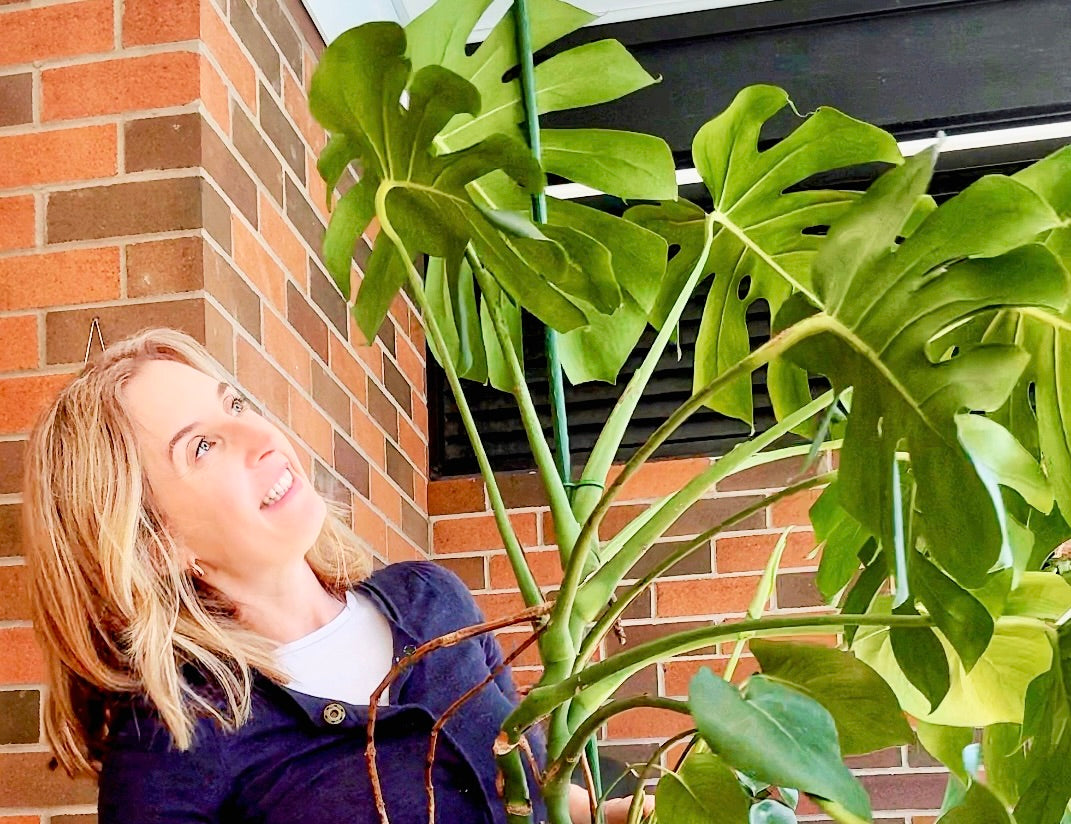
The Complete Guide to Monsteras: Watering, Drainage, Lighting and More
Oops, did you come here for the "Puddle-Free Plant Guide: Tips to Save your Floors and Plants from Mess"? If so, please click here to read now.
(My fault entirely! I gave you the wrong link, sorry!)
If not, please read on for Monstera intell.
Everything You Need to Know about Monsteras
Nothing screams jungle more than Monsteras, which have become one of the most popular houseplants since the advent of social media. It's easy to see to see why: glossy leaves, dramatic fenestrated leaves, bold bushiness or height (depending on your variety), and their easy-going water and light requirements.
Whether you've thought about starting a collection, or already have a home graced with their presence, here are some tips that will make them thrive rather than just survive. We've learned these methods from trial and error over more than 10 years of growing thriving Monsteras of all varieties inside our home and around our outdoor areas.

Monsteras: Popular varieties to know about
While the classic Monstera Deliciosa gets most of the Instagram love, and for good reason, there several competitive siblings deserving of your consideration.

Images (left - right): Deliciosa, Taureii, Adansonii, Thai Constellation (courtesy of @passthatplant in a PerkyPod plant pot)
Here are some of our favourites:
-
Monstera Deliciosa: Undeniably the OG. This iconic specimen produces big and beautiful perforated leaves if you get its lighting right. Flex those fenestrations at your front door or backyard entertaining area for the ultimate green-thumb bragging rights.
- Monstera Taureii: The little sister to the Deliciosa and much lesser-known, this one is a favourite at PerkyPod HQ! She’s got slightly smaller leaves that still get fenestrations, but will form a more bushy array of leaves without growing too tall.
-
Monstera Adansonii: This one is a bit more delicate and suited to trailing over the edge of your pot, or climbing up a moss pole or trellis. It's a favourite for one reason — it's little leaves are just so darn cute!
-
Monstera Thai Constellation: A recent surge in popularity thanks to social media means this variety barely needs an introduction. Variegation results in creamy white streaks, which make it more high maintenance than the other types. Unfortunately white gives the leaves a slightly shorter life span. While peaking at over $200 per plant, I've seen them retailing for around $120 at Bunnings lately, so might be a good time to hop on this trend.
Note: soil flushing (plenty of water in one session) really helps to remove an excess of minerals and salts from your soil, which helps promote a longer life for those variegations!
No matter which variety you choose, the plant care basics don't change too much. Now let's cover some of those...
Drench, Drain, Don’t Drown It!
Pouring some water on your Monstera might sound as simple as doing it whenever you remember. But many people wind up overwatering, which is a certain path towards plant purgatory.
Soggy soil means the roots won't get the oxygen they thrive on, so they rot. Rotted roots equal sad plants. And plant pests. And wasted money. And stress for you. Not good on any count!

Image: Watering a Adansonii thorough (about two seconds later, it started dripping all over my rug!)
Here’s the PerkyPod way to keep your Monsteras hydrated, healthy and happy:
-
Drench your Monstera thoroughly. We’re talking soaking the soil until water drains out the bottom of the pot. But—and this is key—make sure it drains completely. No drama-causing swampy soil, thank you very much.
-
Drainage is essential. Have your pot over a sink or in the shower to check there's water pouring out the bottom and to avoid puddles on your floors. No one has time for water stains and rotting floor boards or carpet (tip: read more on this topic over at our Puddle Free Plant Guide).
- If you have a PerkyPod, its unique water catchment system means you won’t need to worry about water going everywhere. Excess water goes into its nifty drawer, which you can just slide out and empty whenever you have time. Meanwhile, those roots will be enjoying dry feet that have been quenched but not left to rot.
-
Dry out. No need to get too excited with the watering can. Wait until the top quarter to half of the soil is dry before giving it another good drench.
If you adopt the drench and drain approach, pretty soon you'll find your Monstera has become so robust that it will last for a few weeks between watering sessions. Yay for holidays without plant dramas!
Pro tip: Monsteras love humidity, so if you want to spoil them, pop them near a humidifier. Happy leaves = happy life.
Light: Not Too Hot, Not Too Shady!
Monsteras are native to the tropical rainforest zones of Mexico and Central America, so they love the type of dappled light you'd see underneath a canopy of trees.
- Do: make sure to place them close to a window but ensure no direct afternoon light touches its leaves. Afternoon light is hotter than morning light, especially in summer. They do well outdoors in the same conditions too, provided you live in a humid or temperate climate.
- Don’t: while a they could survive for some time in a dark corner, you might find it loses those beautiful fenestrations. It will probably also start stretching out along its trunk and become quite leggy, which isn't an aesthetic that many of us aspire to. To avoid this, try switching your Monstera out with plants in sunnier parts of your home or garden from time to time.
- Pro tip: If you have lots of space, rotate your plant every couple of weeks so it grows evenly on all sides, which is especially suited to a large corner of your home. A PerkyPod plant pot on castor wheels makes spinning and manoeuvring oh-so simple. No strained backs here!

Image: Monstera Taureii sits on an outdoor bench. It helps create a rainforest feel in an home's outdoor entertaining area, especially when mixed and matched with other plants like this Ficus Tineke (bottom left) and Alocasia aka Elephant's Ear (bottom right in a PerkyPod with wheels)
Bonus Tips for Thriving Monsteras
If you follow our tips for watering, draining and lighting, you'll be well on your way to jungle vibes, but here's a few more ways to boost your chances of reaching perky plant joyl.
- Potting mix: like all houseplants, Monsteras thriving in a well-draining blend. We find that a mix of 50% premium potting soil, 25% perlite and 25% orchid bard works well. Well-draining soil is essential to avoid root rot and plant pests, which we cover more in this blog.
-
Support: Monsteras naturally enjoy climbing up a moss pole as this resembles the tree trunks they're used in the rainforest. Connect it in between its leaves with some twine or coated gardening wire. This will encourage the leaves to grow larger and larger up the pole!
- Dusting: As the leaves are quite large, they really benefit from a wipe with a wet cloth every few weeks to ensure they can absorb sunlight. Add some eco neem oil to your water to boost your plant's pest-fighting capabilities, but be sure to wipe this off afterwards.
- Aerial roots: (see image below) You'll see these growing from the nodes along the Monstera stem. They don't serve any purpose other than helping to support the plant if you're growing it on a moss pole. It doesn't cause the plant any harm if you trim them off, or you can keep them and bury their ends in soil when they grow long enough so the plant can absorb some extra nutrients.
-
Pruning: There's nothing wrong with pruning off the oldest leaves if they've become too yellowed or dried around the edges. This process helps promote fuller growth.
-
Propagation: If you're able to, include the base of the stem in your cutting (the "node") so it can grow new roots when placed in water. Place it in soil and, after a couple of months, you'll get a whole new plant!
-
Fertiliser: During the growing season (spring and summer), a balanced, water-soluble fertiliser once a month will keep your Monstera punching out glorious new leaves. We love this one from Plant Runner.
-
Repotting: Consider repotting every two years. You'll know its time if there are roots poking out the drainage holes. Many people think they need to repot as soon as they get a new Monstera home but please don't do this. They love to be fairly root bound and need time to acclimate to their new surrounds before being messed around with too much.
For best results, only repot your plant into a new pot that is around 1" in diameter larger than it's current pot. As previously mentioned, they love to be a bit root bound and upsizing too much means excess soil which could cause root rot.

Image: How to identify nodes and aerial roots
With all this Monstera know-how, you'll be able to turn your home, office and outdoor spaces into a lush paradise. Just remember: drench, drain, and check the light. And with a little help from PerkyPod, you won’t have to sweat the mess!
Happy planting, perky plant parents!

Image: Those huge, glossy leaves are a great addition to indoor or outdoor plant collections. This one is potted up in a PerkyPod, which makes for puddle-free drainage and no back-breaking lifting. Shop now at PerkyPod.

